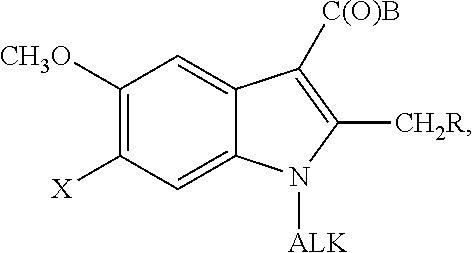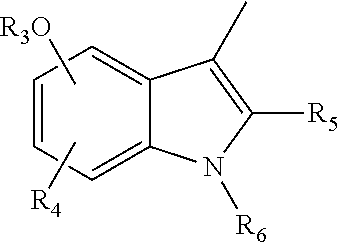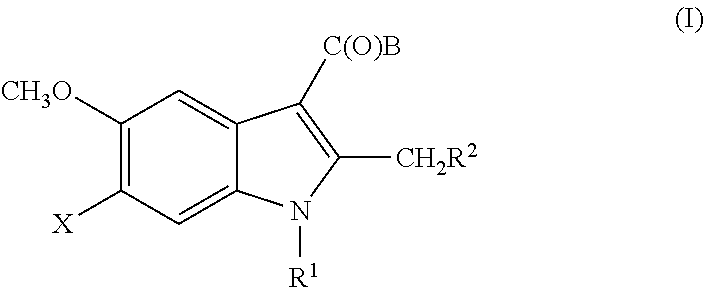5-Substituted Indol-3-Carboxylic Acid Derivatives Exhibiting Antiviral Activity a Method for the Production and Use Thereof
- Summary
- Abstract
- Description
- Claims
- Application Information
AI Technical Summary
Benefits of technology
Problems solved by technology
Method used
Image
Examples
example 1
6-Bromo-1-methyl-5-methoxy-2-(phenylthio)indol-3 carboxylic acid (VI)
[0036]A solution of 3.8 g (0.009 mole) of the ethyl ester of 6-bromo-1-methyl-5-methoxy-2-(phenylthio)indol-3-carboxylic acid, 5 g of caustic soda, and 3 mL of water in 100 mL of ethyl alcohol is boiled for 3 hours. It is partially evaporated in vacuo, water is added to dissolution of the salt, and acidified with concentrated hydrochloric acid while cooling. The precipitate is filtered and washed with water. Yield 3.4 g (92%). Melting point 213° C. (with decomposition from dioxane).
[0037]Found, % C, 52.97; H 3.94. C18H16BrNO3S. Calculated, %: C, 53.91; H, 3.96.
[0038]Similarly obtained:
[0039]6-bromo-5-methoxy-1-phenyl-2-phenylthiomethyl-indol-3 carboxylic acid, melting point 200-202° C. (decomposition, from dioxane), found. %: C, 59.03; H, 4.22; C23H28BrNO3S. Calculated, %: C, 58.96; H, 3.88.
example 2
6-Bromo-1-methyl-5-methoxy-2-(phenylthio)indol-3-carboxylic acid chloranhydride (VII)
[0040]To a suspension of 2.03 g (0.005 mole) of compound VI in 20 mL of dioxane at room temperature are added 2 mL of thionyl chloride and 1 drop of dimethylformamide. This is heated to dissolution in a water bath and left at room temperature for a day. The dioxane and the excess thionyl chloride are distilled off in vacuum; hexane is added to the residue. The precipitate of 6-bromo-1-methyl-5-methoxy-2-(phenylthio)indol-3-carboxylic acid chloranhydride (VII is filtered, washed in hexane, and used in the following step without purification.
example 3
1-{6-Bromo-1-methyl-5-methoxy-2-(phenylthio)methyl-1-H-indol-3-yl}-benzylpiperazine (A)
[0041]To a solution of 1.3 g (0.00306 mole) of VII in 10 mL of benzol are added 0.54 g (0.00306 mole) of 4-benzylpiperazine in 5 mL of benzol and 0.45 mL of triethylamine. This is left at room temperature for a day. The benzol is distilled off in vacuum; water is added to the oily residue, decanted twice with the oily precipitate. Ethanol is added to the residue, the mixture is cooled, and the precipitate filtered. Yield 1.35 g (78.4%). Melting point 167-169° C. (from acetone).
[0042]The hydrochloride is obtained by adding hydrochloric acid to a solution of the base in acetone; melting point 220° C. (from aqueous alcohol)
[0043]Found, %: C, 58.71; H, 5.24; N, 6.84; S 5.28. C29H31BrClN3O2S. Calculated, %: C, 57.96; H, 5.20; N 6.99; S 5.33.
[0044]Similarly obtained:[0045]1-{6-Bromo-1-methyl-5-methoxy-2-(phenylthio)methyl-1-H-indol-3-yl]carbonyl}pyrrolidine (B), Melting point 150° C. (from alcohol).[004...
PUM
 Login to View More
Login to View More Abstract
Description
Claims
Application Information
 Login to View More
Login to View More - R&D
- Intellectual Property
- Life Sciences
- Materials
- Tech Scout
- Unparalleled Data Quality
- Higher Quality Content
- 60% Fewer Hallucinations
Browse by: Latest US Patents, China's latest patents, Technical Efficacy Thesaurus, Application Domain, Technology Topic, Popular Technical Reports.
© 2025 PatSnap. All rights reserved.Legal|Privacy policy|Modern Slavery Act Transparency Statement|Sitemap|About US| Contact US: help@patsnap.com



